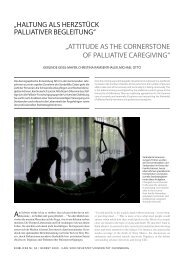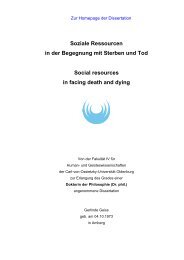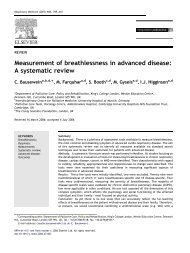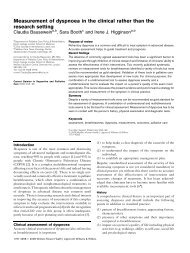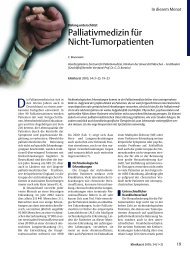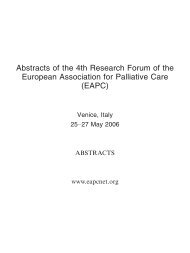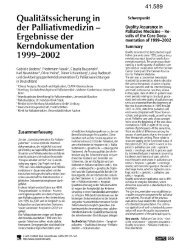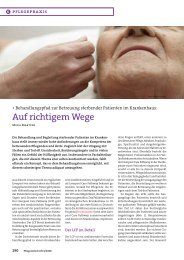EAPC - ipac
EAPC - ipac
EAPC - ipac
You also want an ePaper? Increase the reach of your titles
YUMPU automatically turns print PDFs into web optimized ePapers that Google loves.
418 <strong>EAPC</strong> Abstracts<br />
troubled by uncertainty about the adequacy of their caregiving. However,<br />
patients gave examples both of carer behaviours that promoted selfmanagement<br />
and conversely of those that were experienced as disabling.<br />
This paper critiques the patient focus of most intervention that aims to support<br />
self-management. Drawing on the example of people with advanced<br />
cancer managing eating difficulties, it argues that self-management might<br />
best be facilitated using a family focused approach to supportive cancer care.<br />
Conclusions: Further work is needed to establish the ways in which carers<br />
can be helped to support patient self-management. Reference 1.Hopkinson<br />
J.B. (2007) How people with advanced cancer manage change in eating<br />
habits. Journal of Advanced Nursing. 59(5) 454–462. Acknowledgement<br />
The author would like to thank Macmillan Cancer Support UK for funding<br />
this study.<br />
63 Oral Presentation<br />
Education and Epidemiology<br />
Predictors of palliative care program enrollment in Nova Scotia,<br />
Canada using new analytic methods for improved application<br />
and understanding<br />
Authors: Grace Johnston School of Health Services Administration<br />
Dalhousie University CANADA<br />
Beverley Lawson Dalhousie University Halifax, Nova Scotia CANADA<br />
Jun Gao Cancer Care Nova Scotia Halifax, Nova Scotia CANADA<br />
Ruth Lavergne Dalhousie University Halifax, Nova Scotia CANADA<br />
Frederick Burge Dalhousie University Halifax, Nova Scotia CANADA<br />
Paul McIntyre Capital Health Halifax, Nova Scotia CANADA<br />
Eva Grunfeld Cancer Care Nova Scotia Halifax, Nova Scotia CANADA<br />
Background: Our previous research using multiple logistic regression identified<br />
older age, short time between cancer diagnosis to death, and distance<br />
to the palliative care program (PCP) as being associated with lower PCP<br />
enrollment rates. Using new analytic methods, additional variables, a second<br />
district, and updated years of data, we improved the conceptualization<br />
and understanding of predictors and are better able to translate research into<br />
practice. Methods: Multiple logistic regression, hierarchical modeling, and<br />
classification and regression tree (CART) were used to identify subpopulations<br />
with lower PCP enrollment in a retrospective population based linked<br />
administrative records analysis of 4137 adults who died of cancer from<br />
2000 to 2003 in two largely urban districts in a Canadian province. Results:<br />
PCP enrollment rates continued to improve: from 61% in 1996 to 81.6% in<br />
2003 in one district, and from 46.5% in 1994 to 74% in 2003 in the other.<br />
Primary CART findings were that PCP enrollment for persons dying within<br />
12 days of death differed between the districts (27% vs 47%), and were<br />
lower than for those who survived longer (78%). Nursing home residents<br />
>80 years had lower PCP enrollment rates (32%) than younger nursing<br />
homes residents (75%), or non-residents (80%). The hierarchical regression<br />
model included additional variables and showed, for example, that persons<br />
with >32 days in hospital in the last 6 months of life had higher PCP enrollment<br />
(AOR 1.7; 95% CI 1.4, 2.3). Oncology care and increasing Charlsen<br />
co-morbidity ratings were associated with PCP enrollment. Conclusions:<br />
CART analysis produced more relevant cut points and more clearly identified<br />
subpopulations for investigating lower palliative care program enrollment,<br />
ie better translates research into practice. Hierarchical modeling<br />
improved the conceptualization of variables but results did not differ substantially<br />
from traditional multiple logistic regression. Funding was provided<br />
by the Canadian Institutes for Health Research.<br />
64 Oral Presentation<br />
Education and Epidemiology<br />
Is there an effective method to address the educational needs<br />
of health care workers in Latin America Results of an on-going<br />
Distance Learning Program<br />
Presenting author: Jorge Eisenchlas<br />
Authors: Ernesto Vignaroli Palliative Care Unit Hospital Tornú-Fundación<br />
FEMEBA ARGENTINA<br />
Sofia Bunge Hospital Tornú-Fundación FEMEBA Buenos Aires<br />
ARGENTINA<br />
Clara Cullen Hospital Tornú-Fundación FEMEBA Buenos Aires<br />
ARGENTINA<br />
Roberto Wenk Programa Argentino de Medicina Paliativa-Fundación<br />
FEMEBA San Nicolas ARGENTINA<br />
Liliana De Lima IHAPC Houston U. STATES<br />
Mariela Bertolino Hospital Tornú-Fundación FEMEBA Buenos Aires<br />
ARGENTINA<br />
Background: Education for palliative care workers is crucial in order to<br />
meet the needs of patients. Many care providers face several barriers such<br />
as long distances to learning centers and working schedules with limited<br />
flexibility. Long distance learning (DL) helps eliminate these barriers. The<br />
Programa Argentino de Medicina Paliativa of Fundación FEMEBA in<br />
Argentina developed an online distance course in palliative care in Spanish<br />
to address the needs of health care workers in Latin America. Methods: The<br />
courses are tailored for nurses and doctors. Courses started in 2005 using<br />
Blackboard © software and are ongoing. Each course includes ten one-week<br />
modules, covering specific topics such as communication, pain management<br />
and delirium using case discussions and theory. An online assessment<br />
form is completed by the participants before and after the course. Results:<br />
The number of participants for 2005 and 2006 were 50 and 73 respectively.<br />
Most were doctors and had some palliative care education. The average percent<br />
of students who approved the courses increased from 2005 to 2006<br />
(43 and 60% respectively). The most significant advantages of DL as cited<br />
by the participants is not having to travel long distances, the flexibility in<br />
time schedule and having access to a course in Spanish. Preliminary data on<br />
long term changes in attitudes and practice shows that 6 months after the<br />
course students feel more comfortable managing issues such as opioid side<br />
effects, delirium, breaking bad news, and bereavement support.<br />
Conclusions: Results indicate that DL reduces barriers in education.<br />
Challenges for the course organizers include securing funding and the<br />
development of adequate and useful content. Challenges for the students<br />
include securing access to a computer and the internet. Other organizations<br />
and teaching institutions should also look into different alternative methods<br />
to improve palliative care education in Latin America as an effective way to<br />
improve basic knowledge.<br />
65 Oral Presentation<br />
Other symptoms<br />
A systematic review and meta-analysis of the drug management<br />
of cancer-related fatigue (CRF)<br />
Authors: Ollie Minton Division of Mental Health St George’s University of<br />
london UNITED KINGDOM<br />
Paddy Stone St Georges University of London London UNITED<br />
KINGDOM<br />
Alison Richardson Florence Nightingale school of nursing Kings college<br />
London London UNITED KINGDOM<br />
Michael Sharpe School of molecular & clinical medicine University of<br />
Edinburgh Edinburgh UNITED KINGDOM<br />
Matthew Hotopf Department of psychological medicine; Institue of psychiatry<br />
London UNITED KINGDOM<br />
Background: Fatigue is one of the most common symptoms experienced<br />
by cancer patients. Cancer-related fatigue(CRF)is a complex condition with<br />
many physical and psychological components.Studies have examined the<br />
role of certain drugs to alleviate CRF. However there is no universally<br />
agreed evidence-based drug management for CRF. We therefore decided to<br />
undertake a systematic review to appraise and synthesise the current evidence.<br />
Methods: This review used Cochrane review methodology. We<br />
searched the Cochrane register of controlled trials (2nd Quarter 2007),<br />
Medline (1966 to August 2007) and EMBASE (1980 to August 2007) using<br />
a pre-determined list of search terms. In addition we hand searched a number<br />
of cancer journals and identified relevant conference abstracts. Results:<br />
The review identified 27 trials. A combined meta-analysis of two studies<br />
demonstrated that methylphenidate (a psychostimulant) was superior to



